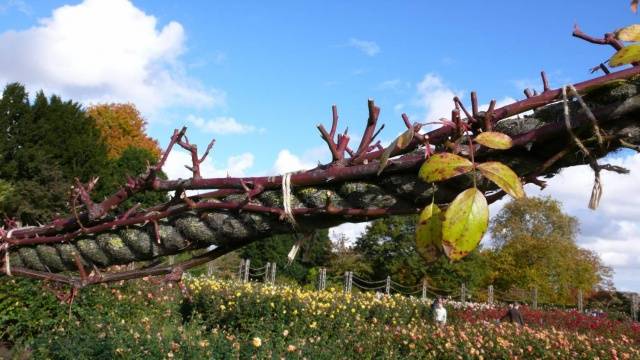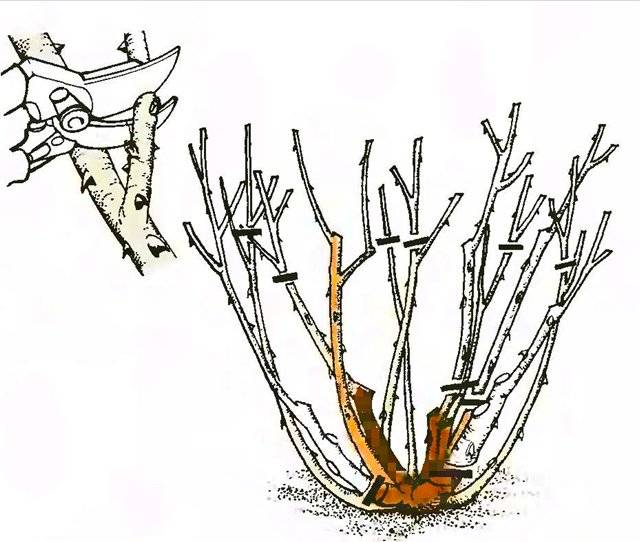Content
Experienced flower growers know that only a well-groomed flower garden will look beautiful and tidy. To do this, you need to clean the area every year. Many people mistakenly believe that climbing roses do not need pruning. But without it, in a few years you will not be able to approach it at all. Unpruned flowers will be difficult to cover for the winter. Therefore spring pruning not only desirable, but also necessary.
Also pruning climbing roses in the spring it will help to form the bush in the correct way so that it does not spill over into neighboring plants and buildings. This pruning will preserve the decorative appearance of your plants for many years. But to do this properly, you need to follow some rules. In this article we will look at how to properly prune climbing roses.
The importance of pruning
Roses are one of the most demanding flowers to care for. It is not enough to simply plant these bushes on your site. In order for them to bloom well, you will have to spend a lot of time. The main part of caring for climbing roses is spring pruning.
By pruning, we not only rid the plant of dry and damaged shoots, but also form a bush. Pruned roses grow faster and have a neat appearance. You can show your imagination and give the bush the desired shape.In any case, thanks to pruning, not chaotic shrubs will grow on your site, but lush and neat plants.
Basic rules for spring pruning
Whatever varieties you grow, it is important to remember the following rules:
- During the year you need to carry out spring, summer and autumn pruning. Spring pruning is the most important. As soon as the frosts begin to recede, you should remove the shelter and get to work. It is important that there is no rain at this time. Pruning of bushes begins in the second year, only planted shrubs do not need it.
- Prepare all the necessary tools. Thin shoots can be trimmed with pruning shears, and dense branches with a hacksaw. The tool must be sharp; this is the only way to get a perfectly smooth cut. Torn cuts can threaten the appearance of various diseases.
- Don't downplay the importance of tool handling. Disinfection will prevent the plant from introducing any fungi. For these purposes, ordinary potassium permanganate is perfect. The solution for treating instruments must be concentrated.
- After pruning, you need to treat all sections with garden pitch or Novikov liquid. The bushes themselves are sprayed with a solution of 1% copper sulfate. For 10 liters of water you will need 100 grams of vitriol.
The main stages of pruning climbing roses:
- the main stem on the bush is cut to the level of healthy tissue;
- 1 cm away from the first formed bud;
- the cut must be made at an angle;
- shoots from the rhizome also need to be trimmed. To do this, you need to lightly dig up the root in the place where it grows and cut it off at the base.
Types of pruning climbing roses
When growing climbing roses, it is very important to prune every season. Such bushes grow very quickly. After missing just one year, the plant may lose its decorative properties forever. It is very important not only to prune, but also to do it correctly. Improper pruning can cause irreparable damage to flowers. There are several ways to prune roses. Now we will see which of them are suitable specifically for climbing varieties.
High and low pruning works best for climbing bushes. With these methods, only small parts of the branches are cut. When the rose grows very rapidly, medium pruning is done. To do this, the branches are cut to 6 or 7 buds. Thanks to this method, the plant will bloom much earlier.
For roses such as polyanthus, floribunda and hybrid tea, heavy pruning of bushes is carried out. In this case, no more than four buds are left on the branch. This method is perfect for planting young seedlings, as well as for rejuvenating an old bush.
Methods for pruning climbing roses
We’ve sorted out the types of pruning, now let’s move on directly to the process itself. There are several purposes for which roses are pruned. This directly determines how it should be done. Let's briefly look at each method:
- Preventative pruning. This procedure is carried out in the spring, as soon as the buds begin to swell. Dead and infected branches are removed from the bush. After this, all shoots are cut back to the first swollen bud. The next step is pruning unripe branches.
- Thinning. To make a climbing bush look aesthetically attractive, it must be carefully shaped. To do this, all side shoots that grow inside the bush are cut off. It is also necessary to remove weak and branching stems.Old branches, as well as wild growth, only interfere with growth and flowering. So we get rid of them too.
- Rejuvenating cleansing. This procedure is suitable for plants older than 3 years. To clean the bush, all branches that look like wood are cut off. They need to be cut at a height of about 30 cm from the root system of the bush. This height will allow the development of young shoots that will soon appear.
Spring pruning
Spring pruning is the most important procedure in caring for roses. The best time to work is March or April. If spring is later in your region, then you should wait a little longer with pruning. There is no need to start pruning as soon as the snow melts. By the time of cleaning, it should already be clear from the bush which branches are healthy and which are not.
Of course, each variety has its own characteristics, and this should be taken into account when pruning. But all of the above principles are suitable for pruning bush roses in general. Let's look at the features of pruning some types of shrubs.
Hybrid tea varieties form flowers on young shoots that have just appeared this year. Therefore, the plant needs to be pruned at a level of 26 cm from the base of the bush. 5 buds are left on the branches themselves.
Climbing roses should be pruned immediately after the cover has been removed.At the same time, all weak and damaged branches are cut off. It happens that shoots that have not had time to form in the fall are damaged under winter cover. To prevent this from happening, buy varieties with flexible branches. In warm climates, such flowers are stronger and hardier. These flowers also require a thinning method of pruning to form a bush.
Don't underestimate the importance of pruning climbing roses. This procedure will help achieve abundant flowering and rapid growth. If you want your roses to delight you and your guests with blooms for many years, do not miss this important event. Without such care, the plant may simply die or turn into an ordinary rose hip.
Summer pruning
Thanks to this seasonal event, the flowering process can be regulated. Most of all, varieties that bloom several times a season need such cleaning. After the first flowering, dried inflorescences form on the bush, which spoil the decorative appearance of the rose.
To clean the bush, trim the upper parts of the shoots. The cut is made above the first developed bud, leaving at least 2 or 3 leaves on the stem. This cleaning will help the bush prepare for the next flowering, and will also save energy that it would have spent on forming fruits.
Additionally, too thick shoots that are directed inside the bush are pruned. Thus, the plant is formed and will have a neater and more beautiful appearance.
Conclusion
Whatever climbing varieties you grow, be it hybrid teas, remontant roses or floribundas, they all need pruning. In this article you were able to see in detail how to prune a climbing rose.Remember that the most important step in caring for these flowers is pruning the rose in the spring. At this time, you need to remove all damaged and dried branches that only interfere with the growth and flowering process. Also, as necessary, you need to carry out summer and autumn pruning. Only by following all these rules can you achieve excellent results and grow the most gorgeous flowers on your site. In the video below you can clearly see how to do it correctly.




















Hello! Judging by the fact that flowering occurred, as you wrote, “on old branches,” we are dealing with a multi-flowered climbing rose. Its buds appear precisely on last year’s shoots. If you remove them, the rose simply will not bloom next year.
The main pruning of climbing varieties is carried out in the spring; for the winter, only all dry, weak shoots that thicken the bush are removed. At 4-5 years old, the skeletal branches begin to gradually change - by this time they will have time to grow old.
Don't rush into pruning. Although you wrote that there are a lot of new shoots, perhaps the rose is just young, it just took root and threw away as many young branches as needed. In a good once-blooming variety, at the beginning of summer the foliage may not be visible behind the buds, this is normal.
What to do now? First of all, remove all dry and broken branches, then the crossing shoots (if they cannot be separated), and those growing in the direction of the support (they simply will not be visible). Leave the rest.
You wrote that young stems are very long. For many varieties this is a varietal feature. But it may be that you overdid it with nitrogen fertilizers, and did not provide enough phosphorus and potassium fertilizers. Try to feed your roses correctly next year. Now is not too late to fertilize them with monopotassium phosphate. Good luck to you!
Thank you, I have this question. I have a climbing rose, exactly the same pink one, it put out a lot of shoots and very long ones, the rose bloomed beautifully on the old branches, but what should I do with the new shoots, should I cut them all or some of them?